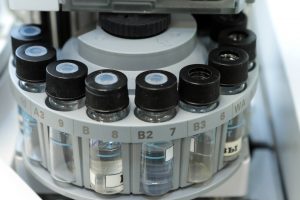Gas chromatography-mass spectrometry is a means of analyzing samples to identify individual substances using the features of gas-liquid chromatography as well as mass spectrometry.
What Is Gas Chromatography-Mass Spectrometry?

Gas Chromatography-Mass Spectrometry is a method that labs use to detect trace amounts of substances in one sample. Lab facilities that perform testing on urine samples use it to uncover anything that contributes to the substance in question.
Not only does it check for specific materials within the sample, but it also is specific and precisely reveals what it discovered. So, if you’ve been having a little too much fun lately, not only will it test positive but they’ll know precisely what kind of fun you’ve been having.
How Does It Work
Let’s talk about science. The gas chromatograph is composed of a heated inlet port and oven. It also contains a fused silica column that the technician will coat with a unique material they call the stationary phase.
Once this is complete, the process is ready to begin. It generally consists of four steps:
- Preparing The Sample: To equip the sample, the technician will dissolve or dilute the sample in a solvent and inject it into the inlet port.
- Vaporizing: The sample turns from liquid to gas through vaporization.
- Separating: The gas then travels through a column. Depending on the gas’s chemistry, the substances will react in different ways with the column stationary phase. Their reaction causes them to move faster or slower through the column, and they separate.
- Detecting: Once separate, the compounds exit the column and move to the mass spectrometer.
The results will appear on a line graph. They represent the separate substances with a peak. The amount of peaks that appear shows how many compounds are in the sample.
History
In 1952, gas chromatography-mass spectrometry testing was developed by Martin and James. However, at that time these machines could only be used in laboratories.
Making computers smaller and cheaper has helped make this test simpler and reduced the time it takes for analysis of a sample. Under the supervision of Robert E. Finnigan, a company called Electronic Associates, Incorporated, which supplied analog computers, started developing a quadrupole mass spectrometer that was controlled by a computer in 1964.
With the help of Mike Uthe, by 1966, Electronic Associates had sold more than 500 gas-analyzers. The Finnigan Instrument Corporation established in 1967, and Perdue and Stanford University got the first prototype of the quadruple gas chromatography-mass spectrometry instrument.
Finnigan Instrument Corporation became the leader, worldwide, in gas chromatography-mass spectrometry systems and ultimately changed its name to Finnigan Corporation.
The high-speed gas chromatography-mass spectrometry instruments were able to analyze fire accelerants in less than a minute and a half in 1966, while the original gas chromatography-mass spectrometry instruments took 16 minutes or more.
Computerized gas chromatography-mass spectrometry units, which use quadruple technology, became one of the leading tools for analyzing organic materials by the 2000s.
This method also became necessary for chemical research by the 2000s. They are now, to an extensive degree, used to monitor water, air and soil environmentally. They also use them for the production and discovery of medicine, and to regulate food safety and agriculture.
The Uses Of Gas Chromatography-Mass Spectrometry
There are many different ways to use gas chromatography-mass spectrometry. It’s sort of a genius invention that has contributed towards a more significant cause on so many levels since its creation.
Gas chromatography-mass spectrometry can be used to investigate fires and explosives, for environmental analysis, to detect drugs and to identify substances of an unknown origin. It can identify elements in materials that used to be considered too disintegrated to locate.
Gas chromatography-mass spectrometry can also detect substances on a human being or in luggage as they pass through airport security.
Because gas chromatography-mass spectrometry testing performs a specific test, it has been considered to be a paragon of excellence when it comes to identifying forensic substances. A test that is specific will show the presence of a particular matter in a specific sample.
A test that is not specific will not show the presence of a specific matter. Instead, it will show the category in which that the matter fits into. The problem with a test that is not specific is that, statistically, it may imply that a particular material is present.
However, this can be misleading, causing a false positive identification.
Outsmarting The Machines
As humans, we’d like to think that we’re smarter than most machines. And indeed we are. At least in this instance. While specific chemists work to uncover recreational substances in urine screenings, there are some who work to keep them hidden.
Synthetic urine is formulated in a lab to match the natural chemicals our body secretes precisely. It has the exact creatine levels, ph balanced, and uric acid.
Is synthetic urine not your forte? That’s okay because Quick Fix also offers a fast-acting detox drink.
Popular FAQs
How can a GC/MS drug test be wrong?
There are certain limitations to all kinds of drug tests. While a gas chromatography-mass spectrometry (GC/MS) drug test may be more accurate than other forms – like mouth swabs – it still has shortfalls. History indicates that it can misidentify mundane substances as illegal ones. When you take a GS/MS drug test, substances represent on a graph in the form of a spike. Sometimes, a legal chemical that is similar to an illegal drug can cause a false-positive. But GC/MS results generally hold up in court.
What does a GC/MS measure?
GS/MS measures the mass of a bodily sample and its contents. It breaks down categories based on ions and takes a look at the mass-to-charge ratio, the molecular fragments, chemical species, ionized atoms, and more. From there, testers will be able to see what types of chemical compounds are in your body. By taking a look at the compounds themselves, there is less room for error.
How is GC/MS used in drug testing?
The gas chromatograph test uses a heated inlet port and a baking mechanism. This process can get confusing in a hurry, so we’ll keep it brief. In short, a GC/MS test samples usually urine or hair, and prepares them in a solvent. From there, the solution is turned into a gas by heating the sample. The gas will sort out the different chemicals comprising the sample, mapping the chemicals (including drug chemicals) into various columns. Based on where they fall, scientists can decipher and chart what was in your system at the time of the drug test.
What is the difference between GC and GC/MS?
The difference between GC and GC/MS tests depends on the type of retention employed with the sample. Gas chromatography (GC) looks at the volatility of a particular chemical at a specific temperature and analyzes the chemical structure. Methanol solvent (MS) tests are virtually the same thing, except they employ methanol to measure retention of the molecules. MS results show after the chemicals present in the sample get charted into columns. GC and MS are pretty much the same tests, different approaches. The GC/MS brings both tests together to maximize the reliability of the results.
Resources
https://www.ncbi.nlm.nih.gov/pubmed/8075776
https://www.nmslabs.com/tests/8098U










